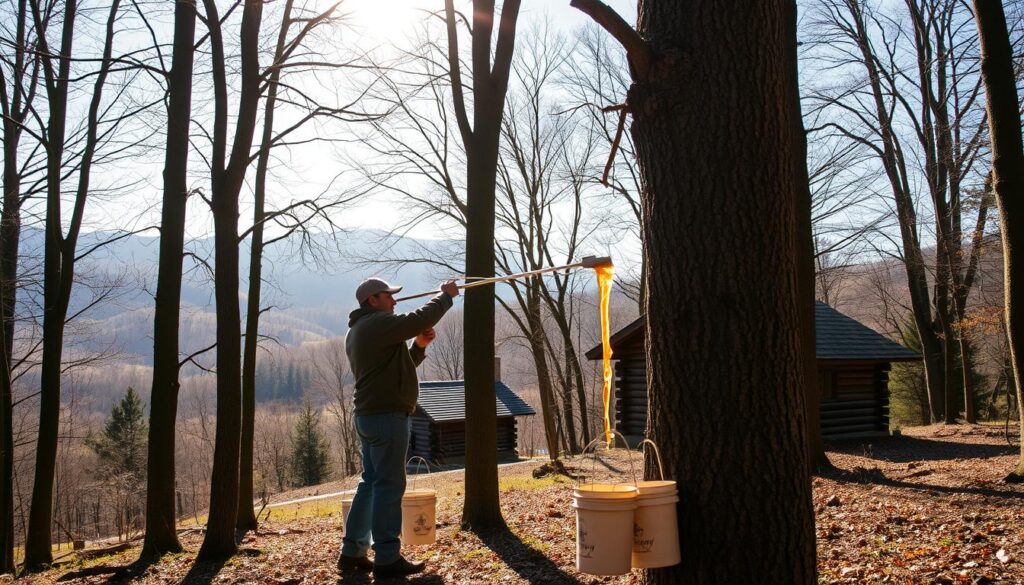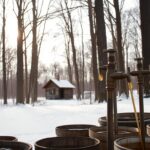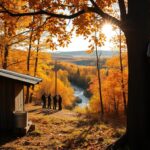Imagine turning a simple tree into liquid gold. Maple syrup tapping is a journey that links passionate producers with North America’s natural heritage. This ancient craft turns maple tree sap into a delicious treasure, enjoyed by many in the United States.
Maple syrup production is more than a food tradition. It’s a mix of human skill and nature’s rhythms. Each syrup drop shares a story of patience, precision, and respect for forests. Sugarmakers need to know a lot about trees, seasons, and special techniques.
The magic starts when nights are cold and days are warm. This makes maple trees release their sweet sap. Skilled producers tap into this, choosing the right trees and using old methods. From Native American ways to modern tech, maple syrup making has grown while staying true to the land.
Whether you love food or want to make syrup, this guide is for you. You’ll learn how raw sap turns into that golden syrup that makes breakfasts special. Get ready for a sweet journey that celebrates nature’s gifts.
Maple syrup tapping is an art that needs dedication, skill, and love for nature. Every gallon of syrup is the result of hours of work and knowing the forest well.
The Rich History of Maple Syrup Production in North America
The story of maple syrup production is deeply rooted in North America’s cultural traditions. It spans thousands of years of innovation and adaptation. Tapping maple trees is more than a culinary practice—it shows human ingenuity and connection with nature.
Indigenous peoples first discovered maple trees’ sweet secret. Their advanced techniques for making maple syrup set the stage for today’s methods.
Native American Origins and Traditional Methods
Native American tribes in northeastern forests developed complex methods for getting maple sap. They understood the seasonal rhythms that made syrup production possible.
- Used wooden tools to make initial tree incisions
- Collected sap in birch bark containers
- Boiled sap using heated stones
- Processed syrup through careful reduction techniques
Colonial Era Developments
European settlers learned from Native Americans how to tap maple trees. They brought metal tools and cooking vessels, changing syrup production methods.
Modern Evolution of Syrup Making
Today, maple syrup production mixes old knowledge with new tech. Advanced equipment and science have changed how sap is extracted and processed.
- Precision tapping techniques
- Mechanical sap collection systems
- Efficient evaporation technologies
- Sustainable forest management practices
The maple syrup industry today respects its cultural roots. It also uses new tech to make syrup better and more efficiently.
Identifying the Perfect Maple Trees for Tapping
Choosing the right maple trees is key for making good syrup. Not all maple trees are the same when it comes to syrup. Sugar maple is the top pick for syrup, with the highest sugar content and best flavor.
When picking maple trees for tapping, look for these traits:
- Tree diameter of at least 10 inches
- Healthy bark without significant damage
- Mature trees between 40-100 years old
- Strong, well-developed root system
Pro tip: The best maple trees will have a full, robust canopy and show no signs of disease or stress.
Different maple species have different sap qualities. Sugar maples are the best, but red and black maples can also make great syrup. Choose trees with straight trunks and few branches for better sap collection.
“A healthy maple tree is like a natural sugar factory waiting to be tapped.” – Maple Syrup Experts
Sugarmakers carefully pick their maple trees. They choose trees that will give good sap without harming the tree. This way, they get quality syrup and help the forest stay healthy.
Essential Equipment for Maple Syrup Tapping
Getting the right sap tapping equipment is key for making maple syrup. Whether you’re tapping a few trees or a whole forest, the right tools matter. They affect how well and how much syrup you can make.
Professional sugarmakers know that good equipment is essential. The right tools make the whole process easier. From collecting sap to making syrup, the right tools help a lot.
Taps and Spiles: The Entry Point of Sap Collection
Taps and spiles start the sap flow from maple trees. They come in different materials and designs:
- Traditional metal spiles
- Modern plastic taps that last longer
- Stainless steel for even longer use
Collection Buckets and Tubing Systems
There are many ways to collect sap, depending on how much you make:
- Traditional Bucket Systems
- Light and easy to handle
- Best for small producers
- Tubing Networks
- Great for big forests
- Less work needed
- Uses gravity or vacuum to move sap
Processing Equipment for Maple Syrup Extraction
To turn sap into syrup, you need special equipment. Here are the main tools:
- Large evaporators for boiling sap
- Tools to control the temperature
- Filters to clean the syrup
- Stuff for bottling and packaging
Choosing the right equipment is important. It makes the syrup-making process smoother and better. This way, you get the best syrup possible.
Understanding the Science Behind Sap Flow
Maple syrup tapping shows us a cool natural process that starts deep inside the tree. It’s all about how trees turn into living gold mines of sweet sap. This magic happens through complex body systems.
In early spring, trees go through big changes because of temperature swings. When it’s warm during the day and cold at night, the tree’s pressure system kicks in. This makes sap flow perfectly.
- Xylem tissues act as natural pipelines for sap transportation
- Osmotic pressure plays a critical role in sap circulation
- Temperature changes trigger internal pressure shifts
During tapping season, the tree’s inside world is very active. Special cells called xylem vessels help sap move from roots to branches. These tiny channels are like highways for sap.
Maple sap is full of water, sugars, minerals, and other stuff. These parts make maple syrup taste so special.
Nature’s engineering enables maple trees to transform stored starches into sugar-rich liquid during seasonal transitions.
Knowing these science facts helps sugarmakers tap maple trees better. They can get more sap without harming the tree.
Best Time of Year for Maple Syrup Tapping
Maple tree tapping needs the right timing to get the sweetest sap. It’s a balance between weather and tree health, needing careful watching and knowledge from sugarmakers.
Good maple syrup comes from knowing how weather and sap flow work together. The best weather makes a natural pump in maple trees, pushing out sweet sap.
Weather Conditions for Optimal Sap Flow
Maple tree tapping works best in certain temperatures. Sugarmakers wait for nights that freeze and days that warm up, usually in late winter and early spring. This mix of cold and warm triggers the sap to move:
- Nighttime temperatures below 32°F (0°C)
- Daytime temperatures around 40-50°F (4-10°C)
- Consistent day/night temperature variations
Regional Tapping Calendar Guide
The tapping season changes in different parts of North America, based on local weather. Sugarmakers must adjust their plans for their area’s climate.
| Region | Typical Tapping Period | Average Duration |
|---|---|---|
| Northeast | Late February – Early April | 4-6 weeks |
| Midwest | March – Mid-April | 3-5 weeks |
| Southeast Canada | February – March | 3-4 weeks |
Climate change is changing when maple syrup can be tapped, making it key for producers to be flexible. Watching local weather is the best way to know when to tap.
Step-by-Step Guide to Maple Syrup Tapping
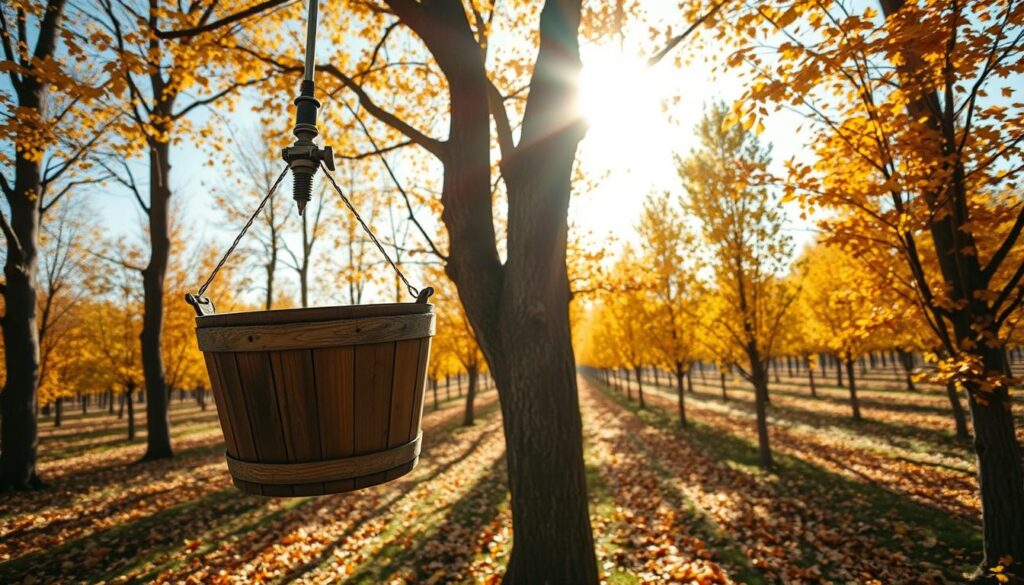
Learning to tap maple trees is a fun journey into making syrup. It needs careful preparation and special techniques for good syrup production.
Before starting, get the right tools:
- Sharp drill with the correct bit size
- Clean spiles or taps
- Collection buckets or tubing system
- Protective gloves
- Sanitizing solution
Pick healthy maple trees that are at least 10 inches wide. Look for trees with lots of sun and little bark damage. The best spot is the south side of the tree for more sap flow.
- Clean the area on the tree trunk
- Drill a hole at a slight upward angle, about 2-3 inches deep
- Make sure the hole fits your spile
- Put in the spile carefully, without too much force
- Attach the bucket or tubing system
Maple syrup making takes time. Each tap can give 10-20 gallons of sap all season. Watch the weather and collect sap often to keep it good.
Experts say tap only 2-3 big trees to avoid harming them.
Be gentle when tapping maple trees to keep them healthy. Clean your tools well and change where you tap each year for sustainable syrup.
Sustainable Practices in Maple Tree Tapping
Sustainable syrup tapping is key to keeping maple forests healthy while making great syrup. It helps trees stay healthy for a long time. This way, we can keep making maple syrup responsibly.
When tapping maple trees, we must think about the forest and the environment. We need to use smart methods that keep trees healthy and the ecosystem balanced.
Tree Health Management Strategies
Here are some important steps to protect maple trees:
- Limit taps per tree based on diameter
- Rotate tapping locations annually
- Use sterile equipment to prevent disease transmission
- Monitor tree recovery between tapping seasons
Environmental Conservation Methods
But it’s not just about the trees. We also need to care for the whole forest. This includes:
- Preserving native maple forest biodiversity
- Implementing carbon-neutral production techniques
- Supporting forest regeneration programs
- Minimizing ecosystem disruption during harvesting
Sustainable practices not only protect maple trees but also ensure future generations can enjoy this natural delicacy.
Sap Collection Process and Storage Techniques
The sap collection process is key in making maple syrup. It needs precision and planning. Sugarmakers use different ways to get the sap from maple trees. Each method has its own benefits for getting more sap.
There are two main ways to collect sap:
- Bucket Collection: This classic method uses metal or plastic buckets on tree taps.
- Tubing Systems: This modern method connects trees with plastic lines.
Vacuum-assisted systems have changed sap collection. They can get up to three times more sap than old methods.
“Efficiency in sap collection determines the quality and quantity of maple syrup produced” – Maple Syrup Producers Association
Storing sap is also important. Sugarmakers need to keep it cold and process it fast to stop bacteria. Big producers use big refrigerated tanks. Smaller ones use insulated containers and quick processing.
Important storage tips include:
- Keep temperatures below 38°F.
- Reduce air and sunlight exposure.
- Process sap in 24-48 hours.
Professional sugarmakers know that good sap collection and storage are key to making great maple syrup.
Converting Raw Sap to Syrup: The Boiling Process
Maple syrup production turns raw tree sap into a tasty golden liquid. This important step needs careful attention to temperature, concentration, and technique.
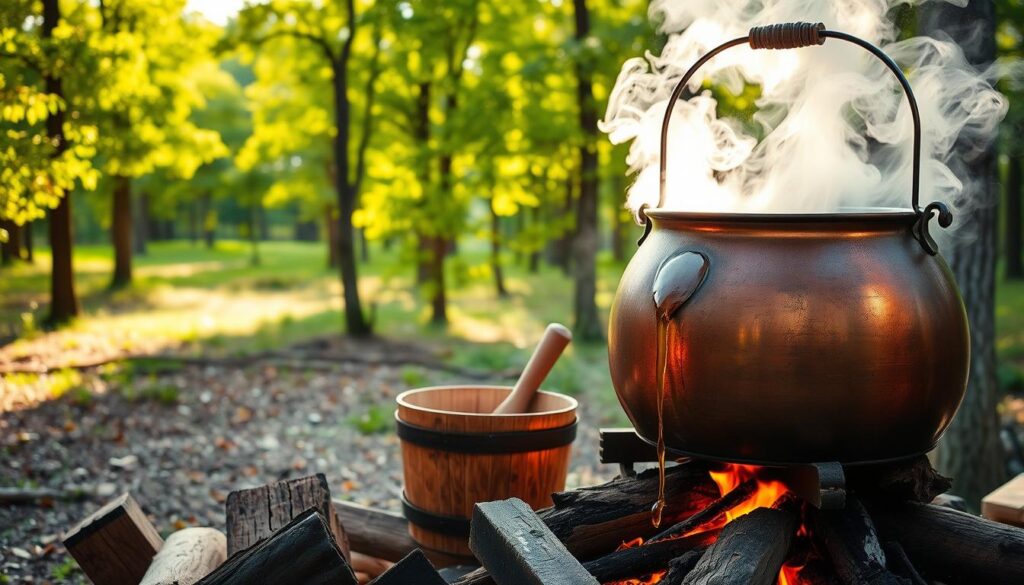
The journey starts with sap from maple trees. Sugarmakers watch the boiling closely. They aim to concentrate the liquid and create the syrup’s rich flavor.
Temperature Control Methods
Keeping the temperature just right is key in making maple syrup. The process involves several important steps:
- Heat sap to about 219°F (104°C)
- Keep the heat steady to avoid burning
- Check the sugar level carefully
- Look for the right syrup density
“The art of maple syrup making is a delicate dance of heat and patience.” – Traditional Sugarmaker
Filtering Techniques
Maple syrup needs careful filtering for a clear, top-quality product. Producers use different methods:
- First hot filtering during boiling
- Using a fine mesh strainer to remove debris
- Final paper or cloth filtration
- Temperature-controlled filtering
Each step is vital for the syrup’s perfect quality and smooth texture. Today’s maple syrup makers use both old and new methods to make the syrup just right.
Quality Testing and Grading Maple Syrup
Maple syrup production needs careful quality testing to ensure top-notch quality. Sugarmakers know grading maple syrup is an art that requires skill and precision.
The USDA sets standards for maple syrup grading. It’s based on color and flavor. This helps people know what they’re getting in their maple syrup.
- Golden Color (Delicate Taste): Lightest grade with mild maple flavor
- Amber Color (Rich Taste): Medium-depth color with robust maple notes
- Dark Color (Robust Taste): Stronger maple flavor with deeper coloration
- Very Dark Color (Strong Taste): Most intense maple flavor profile
During Maple Syrup Tapping, producers use special tools to check syrup quality. Hydrometers and refractometers measure sugar content and density. This ensures the syrup meets high standards.
Quality control also looks for off-flavors or signs of crystallization. Skilled producers watch their syrup closely to keep it at its best.
“Great maple syrup is a reflection of craftsmanship and nature’s precision.” – Maple Syrup Producers Association
Professional maple syrup making means always checking quality. It turns raw sap into a delicious treat that pleases the palate and keeps a valuable tradition alive.
Common Challenges in Maple Syrup Production
Maple syrup making is a precise art that needs skill and flexibility. Sugarmakers face many challenges that can affect their equipment and syrup quality. It’s important to know these obstacles to keep syrup production high.
Success in maple syrup making depends on dealing with environmental and technical issues. Experienced producers always prepare for any problems.
Weather-Related Challenges
Weather is very important in maple syrup production. Unpredictable weather can change sap flow and syrup quality. Key weather challenges include:
- Inconsistent temperature changes
- Unexpected frost
- Prolonged dry spells
- Rapid temperature changes
Equipment Troubleshooting in Sap Tapping
Keeping sap tapping equipment in good shape is key for efficient syrup making. Producers must watch for any equipment problems.
| Equipment | Common Problems | Recommended Solutions |
|---|---|---|
| Taps and Spiles | Leaks and blockages | Regular inspection and replacement |
| Collection Tubing | Damage from wildlife or weather | Protective covering and routine maintenance |
| Evaporators | Mineral buildup and inefficient heating | Periodic cleaning and calibration |
Successful maple syrup production needs constant checking and quick fixes. Proactive maintenance of equipment can avoid big problems during the busy harvesting season.
“In maple syrup production, prevention is always better than cure.” – Vermont Maple Sugar Makers Association
Storage and Preservation Methods for Maple Syrup

Keeping maple syrup at its best is key. It’s not just about tapping the trees. It’s also about how you store it to keep its taste and quality.
There are a few important steps to keep maple syrup fresh:
- Choosing the right containers
- Keeping it cool and away from light
- Stopping bacteria and mold
- Storing it for a long time
The best temperature for storing maple syrup is between 40-50°F. Putting it in the fridge helps it last longer. For small amounts, use glass or plastic containers. For more, stainless steel is better.
| Storage Method | Temperature Range | Expected Shelf Life |
|---|---|---|
| Unopened Refrigerated | 40-50°F | 1-2 Years |
| Opened Refrigerated | 40-50°F | 6-12 Months |
| Frozen | 0°F or Below | Indefinite |
Hot packing is a key method. Heating the syrup to 180-185°F before bottling kills bacteria. This makes it last longer.
Look out for signs of spoilage like bad smells, mold, or bubbles. Sealing well and keeping it cold in the fridge helps avoid these problems. This way, you get a top-quality syrup for your customers.
Economic Aspects of Maple Syrup Production
Maple syrup production is a unique and profitable venture for entrepreneurs and farmers. It offers opportunities for both small-scale producers and large commercial operations.
The financial success of maple syrup tapping depends on several key factors:
- Initial equipment investment
- Land and tree resources
- Production scale
- Market demand
- Regional pricing
Market Analysis Insights
Maple syrup production has seen a big increase in recent years. The United States makes about 4 million gallons of maple syrup each year. Vermont leads in production.
Consumer interest in artisanal and locally produced food products is growing. This trend is good for maple syrup producers.
Pricing for maple syrup varies. It usually costs between $30-$60 per gallon, based on quality and grade. Small producers can earn money through:
- Direct farm sales
- Farmers markets
- Online platforms
- Local specialty stores
Profitability Analysis
Success in maple syrup tapping needs careful planning. A sugar bush with 200 taps can make $4,000-$6,000 a year. Making value-added products like maple candy can boost earnings even more.
The key to making money is knowing your local market and keeping high-quality production standards.
Regulations and Certifications for Maple Syrup Producers
Understanding regulations is key for making maple syrup. Producers need to know about food safety rules and certifications. These rules help them make syrup the right way.
Food safety is very important in maple syrup making. The USDA and state departments have strict rules. These rules help keep the syrup safe for people to eat.
- Get the right state permits for making maple syrup
- Follow FDA food safety rules
- Keep processing areas clean
- Use the right labels
Getting certifications can help maple syrup makers a lot. Organic certification shows they care about the environment. It also draws in customers who want eco-friendly products.
Every place has its own rules for making maple syrup. Makers need to learn about these rules, like for tapping trees on public land. The rules can change by state and county.
“Following the rules is not just about avoiding trouble. It’s about keeping maple syrup making honest and true.” – Maple Syrup Industry Expert
For those making maple syrup for money, knowing and following these rules is very important. It helps them run a legal and successful business.
Conclusion
Maple syrup production is where old traditions meet new ways of farming. It started with Native Americans and now includes green farming methods. This craft links us to nature and ancient skills.
Creating maple syrup takes hard work, knowledge, and a love for forests. It’s about knowing the environment, choosing the right tools, and boiling with care. It’s a hobby or a job that mixes science, skill, and beauty.
Those new to maple syrup can use this guide to grow their skills. By using green methods and keeping quality high, they help keep this tradition alive. The future of maple syrup depends on those who value both new tech and nature.
Maple syrup tapping is not just making a sweetener. It shows our cleverness, care for the earth, and our link to farming traditions. These traditions have helped communities for many years.

